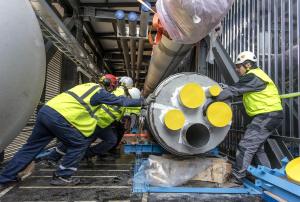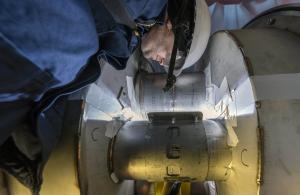Ball joints against earthquakes
In order to reach clients inside the Tokamak Building, cooling fluids produced by the ITER cryoplant flow through many kilometres of highly sophisticated piping called cryolines. Departing from and returning to the cryoplant, the cryolines must pass over an industrial bridge more than 10 metres above the boulevard below. The installation of this double set of cryolines in the cryobridge—the largest measuring one metre in diameter—began in February. Earlier this month the teams successfully performed one of the most challenging operations of the whole installation process: the precise positioning of a 9-tonne cryoline spool designed to decouple displacements between the cryobridge and the Tokamak Building in case of a seismic event.
Along with the steel bellows placed at regular intervals along both the cryolines' inner pipes and outer jackets to compensate for metal contraction due to the flow of intensely cold fluids, the decoupling spools are dimensioned to withstand the displacements that an SL-2 earthquake would cause—an event predicted to occur once every 10,000 years. "In case of a seismic event, even of a lower intensity than SL-2, the Tokamak Building, the Assembly Hall (to which the cryobridge is attached), and the cryobridge itself would each respond in a different manner," explains Lahcene Benkheira, the ITER cryogenic systems responsible officer. "Without a decoupling device, the cryoline network could rupture which—in a nuclear installation—would amount to a loss of confinement." There will be a total of six such decoupling spools in the cryobridge; three of them have already been installed.
Another major element in ensuring the integrity of the cryoline network is the quality of the welding for the 4 or 5 process pipes within every spool. One of the first challenges lies in aligning these massive components that measure between 6 and 9 metres in length and weigh between 2.2 and 9 tonnes. Once the inevitable offsets are compensated (sometimes by workers pushing and pulling) and the protruding process pipes at each end of the spools are almost in contact, the welders, duly qualified, can proceed. The task is difficult, the space constricted, the body contortions sometimes painful but the work gets done, millimetre after millimetre, for a total length of several kilometres.




